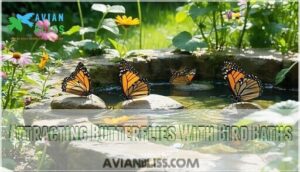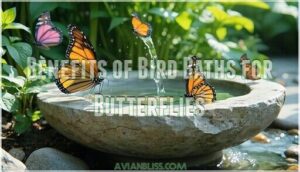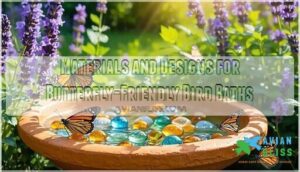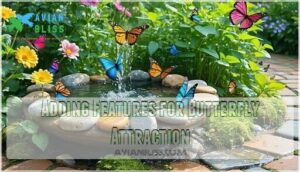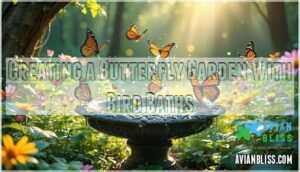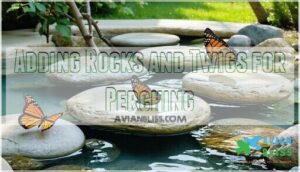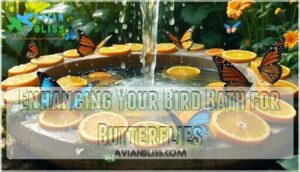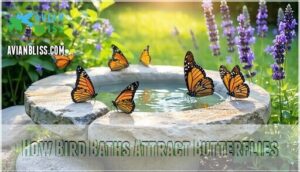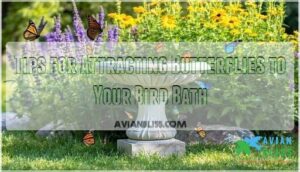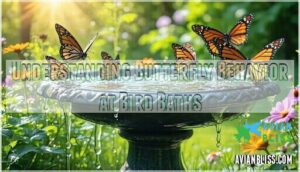This site is supported by our readers. We may earn a commission, at no cost to you, if you purchase through links.
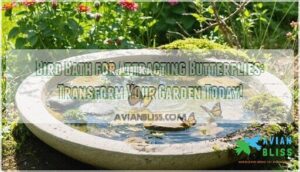
Place it in a sunny spot to keep the area warm and inviting. Add flat stones or twigs for perching and a muddy section for puddling—an essential behavior where butterflies consume minerals from damp soil.
Surround the bath with native plants like milkweed and lantana to provide food and shelter. Keep the water fresh by refilling it often, and avoid harsh chemicals nearby.
With these simple steps, you’ll turn your garden into a butterfly haven that’s as functional as it is beautiful.
Table Of Contents
- Key Takeaways
- Attracting Butterflies With Bird Baths
- Benefits of Bird Baths for Butterflies
- Choosing The Right Bird Bath for Butterflies
- Creating a Butterfly Garden With Bird Baths
- DIY Bird Baths for Attracting Butterflies
- Enhancing Your Bird Bath for Butterflies
- How Bird Baths Attract Butterflies
- Maintaining Your Bird Bath for Butterflies
- Tips for Attracting Butterflies to Your Bird Bath
- Understanding Butterfly Behavior at Bird Baths
- Frequently Asked Questions (FAQs)
- How do you attract birds and butterflies to your garden?
- Do birds like a bird bath?
- What are the best bird bath options & fountains?
- Why do you need a bird bath?
- Do bird baths attract butterflies?
- Why put marbles in a bird bath?
- How do you make a butterfly bath?
- Do butterfly baths work?
- What materials are best for butterfly-friendly bird baths?
- How can water temperature affect butterflies?
- Conclusion
Key Takeaways
- Place a shallow bird bath in a sunny spot, adding flat stones or twigs for safe butterfly perching.
- Create a muddy area for puddling so butterflies can absorb minerals for hydration and reproduction.
- Surround the bird bath with native plants like milkweed or lantana to provide nectar and shelter.
- Keep the water clean and fresh by refilling it often and avoiding chemicals nearby.
Attracting Butterflies With Bird Baths
You can attract butterflies to your garden by creating a bird bath with the right features like shallow water and perching stones.
Create a butterfly-friendly bird bath with shallow water, perching stones, and muddy puddles to support hydration and pollination.
Proper placement and regular maintenance will make it an essential water source for these delicate pollinators.
Bird Bath Features for Butterflies
To create a butterfly haven, start with a shallow water bird bath.
Add perching spots like stones or twigs to give butterflies safe landing options. Incorporate muddy areas as a butterfly puddler to support puddling and nutrient absorption.
Choose durable materials like stone, and consider a solar fountain to maintain freshness. These features will make your butterfly bath an essential butterfly water source.
Adding moving water features can further attract butterflies.
Bird Bath Placement for Butterflies
Give butterflies a reason to visit by placing your butterfly bath where they’ll feel safe and welcome.
Here’s how to make it perfect:
- Sunlight Exposure: Place it in a sunny spot to keep the water warm.
- Predator Protection: Position near shrubs but not too close, preventing lurking predators.
- Wind Protection: Use surrounding plants as a natural barrier from strong winds.
- Ground Level: Keep the butterfly puddler low for easier access.
- Water Depth: Make certain shallow water for safe sips and dips.
Maintenance for Butterfly-Friendly Bird Baths
Keeping your butterfly-friendly bird bath clean guarantees it’s inviting and safe.
Regularly replace the water to maintain freshness while preventing algae growth.
Use a soft brush and mild soap for material cleaning, scrubbing weekly to remove debris.
During winter, protect the bird bath by using de-icers or bringing it indoors.
Maintain puddling areas with moist mud to provide essential nutrients for butterflies.
Consistent bird bath maintenance keeps butterflies hydrated and healthy, guaranteeing they keep returning to your garden for more, which is crucial for their overall well-being.
Benefits of Bird Baths for Butterflies
Bird baths aren’t just for birds; they provide essential water and minerals that butterflies need for hydration and reproduction.
By creating a butterfly-friendly water source, you can support pollinator health and enrich your garden’s ecosystem.
Providing Water Sources for Butterflies
Butterflies need safe water to thrive, and a thoughtfully designed bird bath can meet their unique hydration needs.
A well-designed bird bath offers butterflies a safe, nurturing spot for hydration, nourishment, and vibrant garden enrichment.
Focus on shallow water depth (1-2 inches) to facilitate butterfly hydration. Mud puddles are puddling essentials, providing critical minerals for reproduction and well-being. Enhance mineral absorption by sprinkling small salt patches near water sources.
Try these ideas to attract butterflies and enrich your butterfly garden:
- Shallow bird baths for easy sipping.
- Mud puddles for nutrients.
- Salt-rich zones for mineral needs.
- Clean water sources for a vibrant ecosystem.
Creating a Butterfly-Friendly Environment
Butterflies need more than flowers—they thrive in a complete habitat.
Place a butterfly bath by native flowers like butterfly weed.
Add wind protection and mud puddles for puddling, so they can absorb nutrients.
Skip pesticides to keep them safe.
With water sources nearby, you’ll boost biodiversity while turning your garden into a vibrant butterfly haven.
| Butterfly Need | How to Fulfill It | Benefit to Butterflies |
|---|---|---|
| Water | Shallow butterfly bath | Hydration |
| Nutrients | Mud puddles for puddling | Reproductive health |
| Wind Protection | Shrubs or low walls | Safe feeding and resting |
| Native Flowers | Butterfly-friendly plants | Nectar source |
| No Pesticides | Avoid harmful chemicals | Health and population growth |
Attracting Pollinators to Your Garden
Turn your yard into a vibrant retreat by encouraging pollinator habitats.
Native plants like milkweed and coneflowers offer food and shelter, boosting garden diversity.
Support bees with bee hotels, and butterflies with water sources like a butterfly bath.
Add mud puddles for puddling, where they’ll soak up nutrients.
Skip pesticides—choose butterfly-friendly alternatives to create a thriving, harmonious space.
Choosing The Right Bird Bath for Butterflies
Choosing the right bird bath guarantees butterflies can safely access water for hydration and nutrients.
Focus on shallow, wide designs with added features like rocks and mud to create an ideal environment for their needs.
Materials and Designs for Butterfly-Friendly Bird Baths
When designing a butterfly bath, choose materials that are safe and durable while meeting their needs for hydration and nutrients.
Opt for shallow designs that allow butterflies easy access to water and puddling.
- Terracotta saucers: Natural look, butterfly-friendly.
- Stone materials: Durable and non-toxic.
- Muddy areas: Offers essential salts and minerals.
- Solar fountains: Keeps water fresh, attracts butterflies.
- Weather-proof resin: Safe and long-lasting.
Stick to simple and functional designs.
A butterfly bath with a shallow, wide shape and gentle edges welcomes butterflies while supporting their health and puddling.
You can find various bath materials online.
Size and Depth Considerations for Butterfly Bird Baths
A well-designed butterfly bath should be shallow and wide, offering a water depth of no more than two inches.
A diameter of at least 15 inches guarantees easy access and space for multiple visitors.
Gradual slopes and flat stones provide ideal perching space, while muddy edges support puddling behavior.
Position your butterfly bath in sunny spots, where warmth attracts these delicate creatures.
Shallow water and a well-thought-out design make it inviting and safe for butterflies.
The combination of these features creates an environment that supports the overall health and well-being of the delicate creatures.
Adding Features for Butterfly Attraction
Adding thoughtful features to your bird bath can amplify its charm and turn it into a butterfly magnet.
Butterflies love shallow water paired with muddy areas for hydration and minerals, while flat stones serve as perfect perching spots.
You can also introduce a solar fountain to create gentle water movement, making the space even more appealing.
- Add muddy areas: Butterflies use these for puddling, gathering minerals for reproduction.
- Use native plants nearby: These attract pollinators, creating harmony.
- Incorporate flat stones: Useful perches for resting and sipping.
Creating a Butterfly Garden With Bird Baths
You can create a butterfly-friendly garden by combining native plants with a thoughtfully designed bird bath. This setup provides essential water and nutrients while enhancing your garden’s biodiversity.
Planting a Pollinator-Friendly Garden
A thoughtfully designed butterfly garden pairs beautifully with your bird bath.
Use native flowers like butterfly bush and coneflowers to attract pollinators and promote pollinator diversity.
Plan your garden design around bloom cycles; a simple planting calendar helps maintain a steady nectar supply.
Sustainable practices, such as avoiding chemicals, keep your butterfly habitat safe. To further aid insects, consider adding flat stones or pebbles for safe perching.
These butterfly garden ideas create vibrant spaces buzzing with life while supporting habitat creation and attracting butterflies to your yard.
Incorporating Native Plants and Flowers
Incorporating native plants into your garden enhances biodiversity and boosts butterfly attendance.
Follow these steps for a thriving butterfly haven:
- Choose native plants: Use regional plant guides to select butterfly nectar sources and host plants.
- Plant in clusters: Group plants to make feeding easier.
- Support larvae: Add milkweed or parsley for caterpillars.
Native plants create vibrant, sustainable butterfly garden ideas!
A diverse selection of plants helps support ecosystem health.
Adding a Bird Bath to Your Butterfly Garden
A well-placed birdbath enhances your butterfly garden, blending habitat integration with stunning garden aesthetics.
Choose shallow birdbaths designed for butterfly safety and easy access. Add flat stones for perching and clean water sources to maintain water quality.
- Use durable birdbath materials: Stone, ceramic, or terracotta work well.
- Position near butterfly nectar plants: This attracts butterflies naturally.
- Keep water clean and fresh: Prevent algae and guarantee healthy hydration.
DIY Bird Baths for Attracting Butterflies
You can create a butterfly-friendly bird bath with simple materials and thoughtful design.
By using shallow water, adding rocks for perching, and incorporating gentle movement, you’ll provide an essential water source that attracts and supports butterflies in your garden.
This design will offer a butterfly-friendly environment, making your garden a welcoming space for these beautiful creatures.
Making a Shallow Bird Bath for Butterflies
Designing a shallow bird bath for butterflies is simple and rewarding. Use ideal materials like terracotta for durability and a natural look.
Keep the safe depth shallow, around two inches, for easy access and safe use. Add flat stones or pebbles as perching spots and to help butterflies feel secure.
A muddy area is essential for puddling, where butterflies absorb water and essential nutrients. Consider exploring options for a DIY butterfly bath for more ideas.
Place your bird bath in partial sunlight for warmth and visibility. This thoughtful setup invites butterflies to enjoy your garden while enhancing their environment. It’s a small effort with beautiful rewards!
Creating a Bird Bath With Moving Water
Turn your bird bath into a butterfly magnet with moving water! Adding a pump or solar-powered fountain creates gentle water circulation, attracting butterflies and preventing algae buildup.
Plus, it’s low-maintenance and eco-friendly. Place it near bright flowers for an inviting touch.
You can also find a suitable submersible pump for this purpose.
Here’s what to use:
- Solar-powered options for energy efficiency
- Bird bath pumps for simple flow
- Fountain types suited for gardens
- Eco-friendly maintenance methods
Adding Rocks and Twigs for Perching
How do you make your bird bath butterfly-friendly? Add natural perches! Include materials like flat stones and twigs to create calm landing spots.
Make certain safety by checking rock stability and using non-toxic materials.
Follow these steps to set up:
- Use clean, flat stones for safe butterfly landings.
- Source sturdy twigs that won’t rot quickly.
- Arrange perches at various heights for accessibility.
- Keep everything clean by regularly scrubbing perches to attract healthy butterflies.
Enhancing Your Bird Bath for Butterflies
You can make your bird bath more inviting to butterflies by adding fresh water, mud, and nutrient-rich elements for puddling.
Including fruit slices and using solar-powered features helps maintain the ideal environment while supporting their hydration and nutrient needs.
Adding Fresh Water and Mud for Puddling
Butterflies aren’t just looking for water—they’re also in it for the nutrients.
To create a perfect puddling spot, mix soil, compost, or sand with water, forming rich mud.
Butterflies will appreciate the minerals for nutrient absorption while staying hydrated.
Keep the water shallow—1-2 inches works great for water depth safety.
Fresh water matters too—change it often to guarantee water freshness importance.
By setting your puddling site near plants, you’ll attract more butterflies, turning your garden into their favorite mineral spa!
Incorporating Fruit and Nectar Sources
Adding fruit and nectar-rich plants boosts your garden’s appeal to butterflies.
Place slices of fermenting bananas, oranges, or melons in sunny areas, creating an irresistible butterfly feeder.
Surround your bird bath with seasonal blooms like bee balm or black-eyed Susans for nectar sources.
These offerings provide essential nutrients, supporting butterfly health while attracting hummingbirds and other delightful pollinators.
Using Solar Power for Bird Bath Maintenance
A solar-powered bird bath is an effortless way to attract butterflies while reducing maintenance.
Solar fountains keep water moving, preventing mosquitoes and maintaining cleanliness. Choose quality solar pump types for reliability.
Compare battery lifespan, ensuring uninterrupted operation during cloudy days. Winter storage is simple—just disconnect and protect the solar pump.
Plus, enjoy long-term cost savings and stable water temperature.
| Feature | Benefit | Key Tip |
|---|---|---|
| Solar Pump Types | Efficient water flow | Choose durable models |
| Battery Lifespan | Continuous operation | Check energy storage |
| Water Temperature | Keeps butterflies safe | Avoid overheating |
| Winter Storage | Easy maintenance | Store indoors |
| Cost Savings | Long-term investment | Reduce electricity costs |
How Bird Baths Attract Butterflies
A well-placed bird bath provides butterflies with essential water for hydration and nutrients through puddling.
By adding features like shallow water, sunny spots, and perching areas, you create an irresistible environment for these delicate pollinators.
Providing a Source of Water for Butterflies
Butterflies flock to water for hydration and essential nutrients, so create a haven they’ll love. Keep your bird bath shallow and accessible; butterflies can’t swim! Sprinkle a pinch of salt to mimic puddling minerals and boost their health.
Add flat rocks or twigs for safe water access. Include nearby mud puddles or damp sand to enhance hydration options.
- **Ensure shallow, safe water access.
- **Add salt for butterfly nourishment.
- **Refresh water frequently.
- **Incorporate nearby mud puddles.
- **Use flat rocks for easy perching.
Creating a Sunny Spot for Butterflies
Place your bird bath in a sunny spot to meet the sunlight requirements butterflies need for warmth and energy.
Surround it with native plants like joe pye weed and black-eyed susan to create an ideal butterfly habitat. Guarantee wind protection by selecting a sheltered garden location.
Consider shallow water depths for the safety of smaller butterflies. This setup encourages puddling, providing hydration and nutrients essential for butterfly health.
Attracting Butterflies With Bird Bath Features
Start by creating a butterfly haven with these features:
- Shallow water invites butterflies to sip safely.
- Muddy areas support puddling, providing essential nutrients.
- Perching spots like flat stones give resting space.
- Solar fountains keep water moving, attracting butterflies while staying fresh.
Use safe materials like stone or ceramic.
A bird bath isn’t just decoration—it’s a butterfly magnet!
Maintaining Your Bird Bath for Butterflies
Keeping your bird bath clean and filled with fresh water guarantees butterflies have a safe and welcoming place to hydrate.
Regular maintenance prevents algae, debris, and bacteria from disrupting their habitat and health.
Cleaning and Refilling Your Bird Bath
Keeping your bird bath clean is key to maintaining water freshness and inviting butterflies.
Scrub the surface gently with safe cleaners to remove debris without harming wildlife. Always rinse well, then refill with fresh water every couple of days to guarantee proper water depth.
This routine prevents stagnation and algae build-up, making your garden an appealing spot for butterflies year-round, even during winter maintenance, by ensuring proper water depth.
Preventing Algae and Bacterial Growth
Algae and bacteria in your bird bath can be a hassle, but keeping them at bay is simple with a little effort and routine scrubbing.
Here’s how to keep things pristine:
- Scrub weekly with a stiff brush and a nontoxic cleaner.
- Use a vinegar solution (1:10 ratio) for natural cleaning.
- Add copper pennies as safe algae prevention.
- Maintain good water circulation with a fountain.
- Regularly refresh the water.
Keeping Your Bird Bath Free of Debris
A clean bird bath is essential for attracting butterflies.
Stagnant water and debris like leaves or twigs can spoil their experience.
Stick to a routine: change water weekly to maintain freshness and reduce algae buildup.
Use a skimmer or gloves daily for leaf removal, preventing water contamination.
Add pebbles to shallow areas for natural filtering and insect control.
Inspect the bowl for cracks or damage biweekly.
Monthly, scrub with mild soap to keep it spotless.
Keeping water fresh promotes a vibrant, butterfly-friendly haven in your garden.
Tips for Attracting Butterflies to Your Bird Bath
To attract butterflies to your bird bath, place it near butterfly-friendly plants like milkweed or zinnias and make certain the area is free of pesticides.
Adding a windbreak with shrubs or tall grasses can create a calm environment that encourages butterflies to visit regularly.
Planting Butterfly-Friendly Plants Nearby
Bring your garden to life by planting butterfly-friendly plants near your bird bath.
Native plantings like butterfly weed and bee balm offer nectar sources and larval host spots for pollinator diversity.
Follow these tips for a vibrant butterfly garden design:
- Pick sun-loving, pollinator-friendly plants for blooms.
- Space plants properly for growth and sunlight access.
- Water and prune often to maintain healthy, inviting blooms.
Avoiding Pesticides and Herbicides
Explore organic alternatives to shield your garden and protect butterfly health.
Explore safe pest control options like inviting natural predators or applying homemade sprays.
Avoid chemical pesticides as they disrupt the delicate garden ecosystem.
Instead, embrace safe gardening practices by focusing on native plants and a pesticide-free landscape.
Your thoughtful approach guarantees thriving butterflies and a balanced, lively yard.
Creating a Windbreak for Your Bird Bath
Your bird bath’s location can make or break its butterfly appeal.
Adding a windbreak lets you create a calm, inviting space that butterflies love. Use dense shrubs, like holly or boxwood, as effective wind barriers, or consider installing a lattice structure nearby.
These materials block gusts while blending beautifully into your garden. Smart plant selection can even attract more pollinators.
Keep design practical—maintain easy access for cleaning and refilling. A well-placed windbreak protects the bird bath, supports butterfly activity, and enhances your yard’s charm effortlessly.
Understanding Butterfly Behavior at Bird Baths
Butterflies rely on shallow water sources like bird baths to stay hydrated and gather nutrients essential for survival.
Observing their unique puddling behavior reveals how they absorb minerals needed for reproduction, making your bird bath a valuable resource.
Why Butterflies Need Water Sources
Butterflies don’t just flutter for fun—they need water sources to stay active and healthy.
While they sip nectar for energy, they rely on puddling for hydration and mineral absorption.
Mud puddles or shallow bird baths offer nutrients essential for reproduction support.
Here’s why it matters:
- Butterfly Hydration: Keeps wings flapping and bodies thriving.
- Mineral Absorption: Powers essential biological functions.
- Puddling Importance: Males gather salts for mating success.
- Garden Biodiversity: Enhances balance in your outdoor haven.
Puddling Behavior in Butterflies
Male butterflies gather in mud puddles for a fascinating behavior called puddling.
By sipping from these moist areas, they absorb essential salts and minerals.
These puddling nutrients aren’t just for hydration—they boost male vitality and enhance reproductive success.
Group puddling is common, creating a scene of butterflies clumped together, busy acquiring minerals that females need during mating.
It’s nature’s nutrient exchange!
How Bird Baths Support Butterfly Reproduction
Butterflies rely on puddling to absorb minerals and salts that boost reproductive success and sperm enhancement.
These nutrients improve egg survival and guarantee healthier mating.
Bird baths can support this behavior when you add shallow water and muddy areas.
Keep your garden welcoming by providing safe, clean water sources.
Shallow baths are ideal for attracting pollinators.
- Encourage puddling: Add salt to muddy spots for mineral acquisition.
- Promote egg survival: Keep water fresh and free of pollutants.
- Boost attraction: Surround your bird bath with vibrant plants appealing to butterflies.
Frequently Asked Questions (FAQs)
How do you attract birds and butterflies to your garden?
Did you know pollinators are responsible for 75% of flowering plant reproduction.
Attract birds and butterflies by planting native flowers, adding a sunny bird bath with shallow water, and avoiding pesticides to create a safe haven.
Do birds like a bird bath?
Water draws birds naturally, offering essential hydration and a rejuvenating spot for preening.
They prefer shallow baths with easy access and safe perching.
A clean, well-placed bird bath becomes a backyard oasis for feathered visitors.
What are the best bird bath options & fountains?
A bird bath with a wide, shallow bowl, fade-resistant finish, and solar-powered fountain creates the perfect oasis.
Add pebbles for safe perching, ensuring easy access, durability, and water movement for ultimate attraction and functionality.
Why do you need a bird bath?
A bird bath creates a essential water source for hydration and cooling, supports ecosystems, and attracts diverse wildlife.
It’s more than decoration—it’s an invitation for birds, bees, and butterflies to thrive in your space.
Do bird baths attract butterflies?
Butterflies aren’t all about flowers—they’ll sip from bird baths, too, especially shallow ones with rocks or mud.
These features mimic natural puddles, letting butterflies hydrate and absorb essential minerals, boosting their health and reproduction.
Why put marbles in a bird bath?
Adding marbles gives birds and insects a safe place to perch while drinking.
The shiny surface attracts attention, while preventing water from being too deep.
It also creates a decorative, inviting look for your garden.
How do you make a butterfly bath?
Create a butterfly bath with a shallow dish, about 1-2 inches deep.
Add pebbles or flat stones for perching.
Include a muddy area for puddling, and place it near native plants for an inviting habitat.
Do butterfly baths work?
Imagine creating a tiny oasis that works wonders!
Butterfly baths absolutely work, offering hydration and nutrients through shallow water and puddling areas.
They support reproduction, boost biodiversity, and attract pollinators, enhancing your garden’s charm and balance, with pollinators being a key factor.
What materials are best for butterfly-friendly bird baths?
Pick durable materials like ceramic, stone, or terracotta for butterfly-friendly baths.
They hold water well, resist weather, and stay safe for delicate wings.
Add some flat stones or pebbles for easy perching and puddling space.
How can water temperature affect butterflies?
Butterflies prefer lukewarm water—too cold shocks them, while overly warm water dehydrates quickly and may repel them.
Keep the water rejuvenating but not icy, creating an inviting spot for hydration and nutrient absorption.
Conclusion
Just like crafting a puzzle, setting up a bird bath for attracting butterflies requires the right pieces.
A shallow, sunny dish with added perches and a muddy spot offers essential water and minerals.
Surround it with native plants to enhance the habitat and keep water clean by renewing it frequently.
With minimal effort, you’ll create a thriving butterfly haven that supports pollination and adds natural beauty to your garden.
Start today and watch nature flourish!
- https://www.almanac.com/plant/bee-balm
- https://www.thespruce.com/joe-pye-weed-eupatorium-purpureum-1402848
- https://www.allaboutbirds.org/attract-birds-with-birdbaths/
- https://www.audubon.org/news/why-you-should-keep-your-birdbath-clean
- https://www.birdwatchersdigest.com/bwdsite/learn/top10/attract-birds-with-water.php

